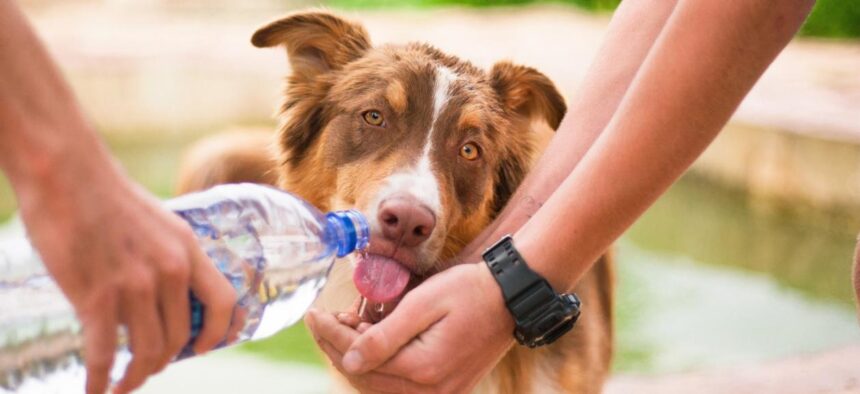That 85-degree day in Summerville? Your car’s interior just hit 125 degrees in 20 minutes. While most pet parents know the basics about keeping their furry friends cool, the humid South Carolina climate creates unique challenges that go far beyond providing shade and water.
Living in the Lowcountry means dealing with oppressive humidity that makes even moderate temperatures dangerous for pets. Unlike humans who cool themselves through sweating, dogs and cats rely primarily on panting – a system that becomes woefully inadequate when humidity levels soar above 80%. Professional veterinary guidance becomes essential for navigating these regional heat hazards that can turn a routine walk into a medical emergency.
Why Southern Heat Hits Different
Dogs and cats have limited sweat glands, found only in their paw pads1. Their primary cooling mechanism – panting – works through evaporative cooling as moisture leaves their nasal cavity and mouth. But here’s the problem: when humidity exceeds 80%, this natural cooling system becomes ineffective.
The coastal moisture in areas like Summerville creates a perfect storm. That 80-degree morning feels manageable until you realize your pet’s body temperature can spike to dangerous levels within minutes. Normal body temperature for pets ranges between 101-102.5°F, but anything above 104°F signals serious trouble.
Recognizing Heat Stroke Before It’s Too Late
Most pet owners miss the early warning signs. Sure, everyone knows about excessive panting, but what about the subtle changes that happen first? Watch for restlessness, seeking shade obsessively, or thick, ropey drool instead of normal saliva.
The progression happens fast. Early signs include increased thirst and heavy panting. As conditions worsen, you’ll notice bright red or pale gums, drooling, weakness, and coordination problems. Advanced symptoms – collapse, bloody vomiting, seizures – mean you’re already in emergency territory.
Here’s what many don’t realize: dogs that lose consciousness may stop panting despite having dangerously high body temperatures. These cases require immediate, aggressive cooling.
The Pavement Problem Nobody Talks About
While air temperature reads 80°F, asphalt can reach 120°F or higher6. Dark surfaces absorb and retain heat differently than concrete, creating hot spots that can burn paw pads in seconds.
The simple hand test works: if you can’t hold your palm on the pavement for five seconds, it’s too hot for your pet. Paw pad burns show up as reluctance to walk, excessive licking, or darkened, damaged pads. When this happens, clean with antibacterial soap and apply antiseptic care while scheduling a vet visit.
Smart pet parents adjust their routines. Early morning walks before 7 AM or evening strolls after 7 PM avoid peak heat. Consider protective booties for dogs who must walk on hot surfaces, or explore grassy areas and shaded trails instead.
Car Dangers: The 20-Minute Rule
Even with windows cracked, car temperatures rise 20°F in just 10 minutes. After an hour, that 70-degree day creates a 110°F+ interior. The “quick errand” mentality kills pets every summer.
What’s shocking? Even running cars with air conditioning can fail. Mechanical problems, accidentally turned-off AC, or system overload in extreme heat can create deadly conditions faster than you’d expect.
High-Risk Pets Need Extra Attention
Brachycephalic breeds – Bulldogs, Pugs, Boston Terriers, Persian cats – face the highest risk. Their shortened airways make panting less effective, and they can’t cool themselves efficiently even in moderate heat.
Overweight pets struggle too. Extra insulation makes temperature regulation harder, while the additional weight stresses their cardiovascular system. Senior animals and very young pets also have compromised thermoregulation abilities.
Thick-coated breeds like Huskies and Maine Coons seem obvious candidates for heat problems, but here’s the twist: never completely shave double-coated breeds. Their fur actually provides insulation against heat when properly maintained through regular brushing.
Emergency First Aid That Saves Lives
If you suspect heat stroke, move your pet to shade immediately and start cooling while someone calls the vet. Use cool (not cold) water to avoid shock. Pour water over their body, focusing on the head, stomach, armpits, and feet.
Never use ice water – it can cause blood vessels to constrict, actually trapping heat inside. Wet towels placed over the pet can worsen the condition by trapping heat. Instead, place towels underneath and keep air moving with fans.
Continue cooling until breathing settles, but stop if shivering begins. The goal is reducing body temperature to 103°F, then getting professional care immediately.
Professional Care Makes the Difference
Heat stroke requires veterinary treatment even after successful initial cooling. Coastal Creek Animal Hospital’s same-day appointment availability becomes critical during summer emergencies, as complications like kidney failure, brain swelling, or blood clotting abnormalities can develop hours later.
Treatment typically includes IV fluids, oxygen therapy, and monitoring for secondary complications. The survival rate jumps from 50% to 80% when cooling begins before reaching the hospital.
Prevention Beats Treatment Every Time
Smart pet parents schedule pre-summer wellness checks to identify risk factors. Weight management, breed-specific advice, and medication adjustments for hot weather all play roles in prevention.
Create multiple water stations throughout your home and yard. Add ice cubes to keep water cool, and consider elevated beds for better air circulation. Cooling mats provide relief, but supervise their use to prevent chewing.
The Lowcountry’s unique climate demands year-round vigilance. What seems like a pleasant spring day can quickly become dangerous when humidity spikes. By understanding these advanced heat safety principles, pet parents can enjoy South Carolina’s beautiful weather while keeping their furry family members safe and comfortable.
Remember: when in doubt, err on the side of caution. Your pet’s life may depend on recognizing these subtle warning signs before they become emergencies.






